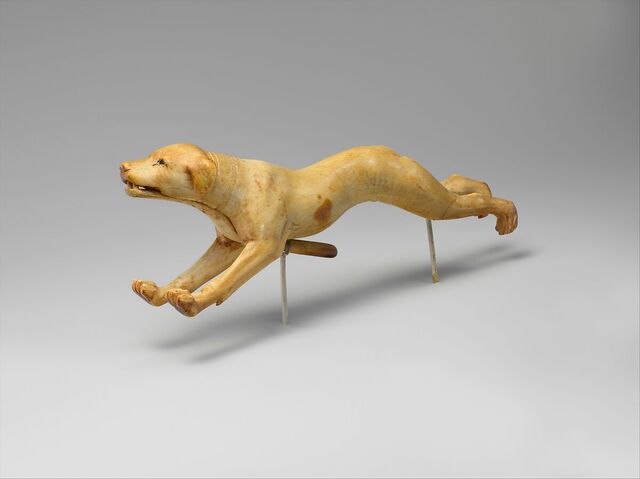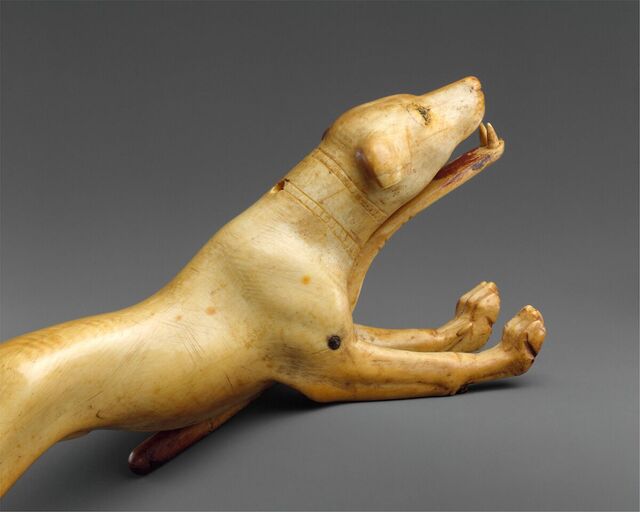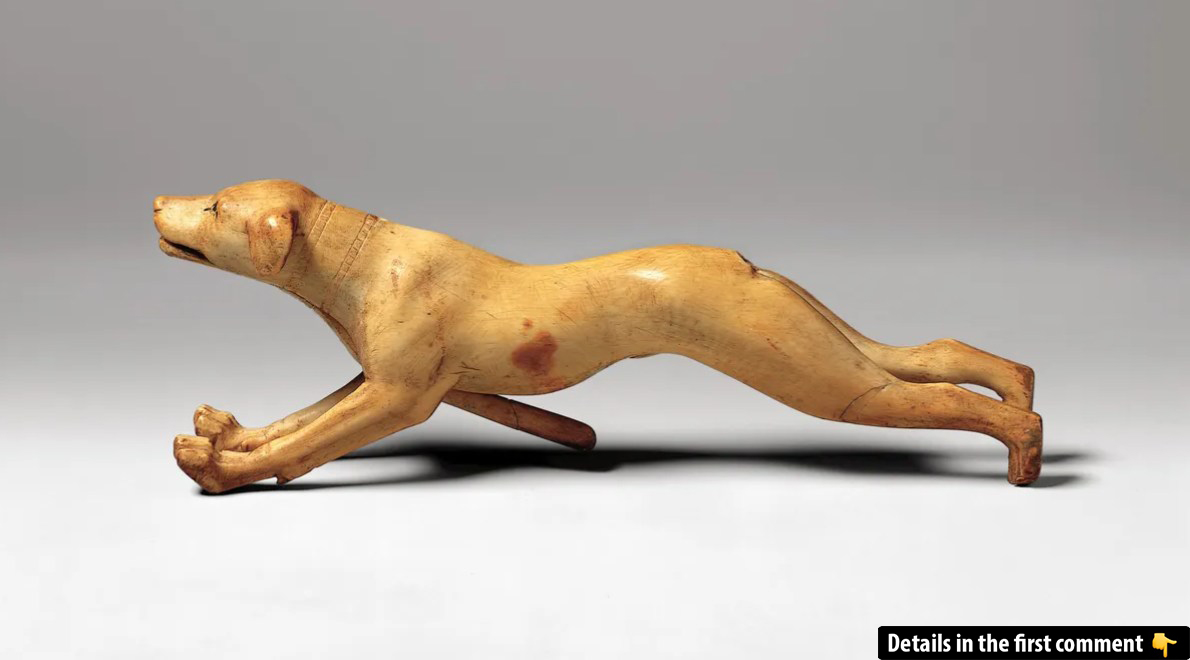The discovery of an ivory dog sculpture from ancient Egypt has captured the fascination of archaeologists and the public alike. This small, carved dog isn’t just a piece of art; it represents a 3,400-year-old link to the past that showcases the ancient Egyptians’ ingenuity and their deep affection for domesticated animals. Known as the “Mechanical Dog,” this moving sculpture, with its impressive craftsmanship, was created during the New Kingdom, specifically during the reign of Amenhotep III, one of Egypt’s most prosperous pharaohs. The “Mechanical Dog” serves not only as an artistic marvel but also as a testament to the cultural significance of pets in ancient Egyptian society.
Unveiling the Artifact: Description and Composition
The “Mechanical Dog” is a beautifully crafted ivory sculpture, measuring approximately 7.2 inches (18.2 centimeters) long. The dog is depicted mid-gallop, its legs stretched out in the air, which immediately conveys a sense of movement. But what truly makes this sculpture remarkable is its functionality. A lever mechanism, located beneath the dog’s chest, allows the mouth to open and close. When operated, the dog’s mouth reveals two lower teeth and a striking red tongue. This mechanical feature is a rarity in ancient art, indicating the sophistication of Egyptian craftsmanship during the 14th century BCE.

Made from elephant ivory, the sculpture exemplifies the Egyptians’ mastery of materials and their intricate attention to detail. The ivory used in the creation of the “Mechanical Dog” was likely sourced from elephant tusks, a commodity that was highly valued and sometimes traded across vast distances. The craftsmanship of the piece is evident in its lifelike portrayal of a dog in motion, a feature that adds both realism and charm to the sculpture. Despite its age, the piece remains immaculately preserved, with the original gems still in place, including a colorful collar that signifies the dog’s domesticated status.
Video
Watch the video to learn why dogs were so important to ancient Egyptians.
The Purpose of the “Mechanical Dog”
While the exact purpose of the “Mechanical Dog” remains speculative, there are several theories that have been proposed by experts. One possibility is that the sculpture served as a toy, designed for entertainment or as a demonstration of mechanical ingenuity. Given the period’s technological advances, toys with movable parts were not uncommon in elite Egyptian households, and they often served as both playthings and symbols of wealth and refinement.
Another theory suggests that the “Mechanical Dog” may have had a more ceremonial or spiritual role. The Egyptians were known for incorporating symbolic representations in their religious and cultural practices, and this dog could have been part of a ritualistic setting. Some experts have even speculated that it could have been used in religious ceremonies to invoke the protection or favor of the gods, particularly Anubis, the god of the afterlife, who is often depicted with the head of a jackal or dog. This connection between the “Mechanical Dog” and Anubis aligns with the symbolic roles that dogs played in Egyptian spirituality.
Cultural Significance of Dogs in Ancient Egypt
Dogs held a special place in ancient Egyptian society, not only as companions but also as symbols of loyalty and protection. While some dogs were used for practical purposes, such as hunting, shepherding, or acting as watchdogs, others were kept as pets. This affection for dogs is reflected in the numerous dog collars that have been discovered in tombs, often inscribed with the dogs’ names or titles. These collars were not just functional but were also seen as a mark of the dog’s status and importance within the household.
The “Mechanical Dog” is a clear representation of the love the ancient Egyptians had for their pets. The collar inscribed on the dog’s neck is a direct link to the domesticity and status of dogs in Egyptian society. The connection between dogs and the elite is further evidenced by the fact that the “Mechanical Dog” was likely placed in an elite tomb during the reign of Amenhotep III, indicating that this artifact was not only a piece of art but also a reflection of the cultural values of the time.
The Historical Context: Amenhotep III’s Egypt

The “Mechanical Dog” was created during the reign of Amenhotep III, a pharaoh known for his extensive building projects and diplomatic endeavors. His reign (ca. 1390–1352 BCE) marked a period of prosperity for Egypt, with the kingdom reaching the height of its power and wealth. During this time, Egypt was a hub of cultural and artistic innovation, with artists and craftsmen pushing the boundaries of their work. The “Mechanical Dog” is an example of the advanced technological skills possessed by Egyptian artisans, who were able to create such intricate and functional pieces of art.
The Afterlife Connection: Dogs and the Divine
In Egyptian mythology, dogs were often associated with the afterlife and the gods, particularly Anubis, who was believed to guide souls through the underworld. This divine connection likely contributed to the reverence Egyptians held for their dogs. Dogs were often mummified and buried with their owners to ensure that they would accompany them in the afterlife. The “Mechanical Dog” could have symbolized this transition between life and death, serving as a reminder of the loyalty and protection that dogs represented both in life and in the spiritual realm.
The idea that dogs were seen as intermediaries between the living and the dead is supported by the practice of burying them in special pet cemeteries. The “Mechanical Dog” may have been more than just a decorative object; it could have been a part of a larger spiritual or funerary ritual aimed at honoring the connection between dogs and the afterlife.
Video
Watch the video to discover why ancient Egyptians were buried with pets.
Conclusion: The Enduring Legacy of the “Mechanical Dog”
The “Mechanical Dog” stands as a testament to the sophistication and ingenuity of ancient Egyptian craftsmanship. Its creation during the New Kingdom reflects not only the artistic skill of the time but also the deep cultural significance of dogs in Egyptian society. Whether it was used as a toy, a ceremonial object, or a symbol of the gods, the “Mechanical Dog” encapsulates the multifaceted role that animals, particularly dogs, played in ancient Egyptian culture.
Today, the “Mechanical Dog” continues to captivate the imagination of those who encounter it, reminding us of the enduring connection between humans and their pets. As it remains on display in The Metropolitan Museum of Art, this artifact provides valuable insight into the daily lives, beliefs, and artistic achievements of the ancient Egyptians, ensuring that the legacy of this “good boy” lives on for generations to come.



